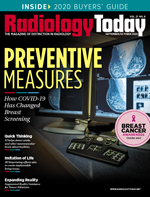 MRI Monitor: On the Lookout
MRI Monitor: On the Lookout
By Beth W. Orenstein
Radiology Today
Vol. 21 No. 8 P. 32
Study suggests physicians should watch for neurological complications from COVID-19.
Physicians are seeing many types of neurologic complications in COVID-19 patients, including acute disseminated encephalomyelitis (ADEM), a rare and sometimes fatal inflammatory condition. A study recently published in the journal Brain found a higher than expected number of COVID patients with neurological conditions including ADEM, but their conditions did not always correlate with the severity of their respiratory symptoms.
In a press release about the study, joint senior author Michael Zandi, MA, MB, BChir, PhD, FRCP, a consultant neurologist at the National Hospital for Neurology and Neurosurgery, Queen Square and University College London Hospitals (UCLH), London, said, “Whether we will see an epidemic on a large scale of brain damage linked to the pandemic—perhaps similar to the encephalitis lethargica outbreak in the 1920s and 1930s after the 1918 influenza pandemic—remains to be seen.” Still, he said, those treating COVID-19 patients should be “vigilant and on the lookout” for neurological complications.
The study provides a detailed account of neurological symptoms of 43 patients, ages 16 to 85, who were treated at the National Hospital for Neurology and Neurosurgery, UCLH, who either had confirmed COVID-19 or were suspected to have COVID-19. The researchers identified 10 cases of transient encephalopathies—temporary brain dysfunction—with delirium, 12 cases of brain inflammation, eight cases of stroke, and eight others with nerve damage, mainly Guillain-Barre syndrome, which usually occurs after a respiratory or gastrointestinal infection. Nine out of the 12 patients with brain inflammation conditions were diagnosed with ADEM.
ADEM can be triggered by viral infections. Ordinarily, the London team would encounter one adult patient with ADEM per month. The team members became alarmed when they started seeing at least one per week during their study period. The virus causing COVID-19, SARS-CoV-2, was not detected in the cerebrospinal brain fluid of any of the patients tested. That it was not detected suggests that some neurological complications of COVID-19 might come from the immune response, rather than the virus itself, according to the researchers.
Per joint first author Ross Paterson, PhD, “Given that the disease has only been around for a matter of months, we might not yet know what long-term damage COVID-19 can cause. Doctors need to be aware of possible neurological effects, as early diagnosis can improve patient outcomes.”
A Need for Vigilance
Radiologists in the United States believe this study should grab the attention of those treating patients with COVID-19. Vincent P. Matthews, MD, FACR, chairman of radiology at Froedtert Hospital/Medical College of Wisconsin, says many early reports of neurologic complications in COVID-19 patients were isolated case reports or small series. However, he says, “This paper is a relatively large series of 43 patients and demonstrates a spectrum of neurologic entities including encephalopathies, inflammatory central nervous system (CNS) syndromes, ischemic strokes, peripheral neurologic disorders, and miscellaneous CNS disorders of which radiologists and clinicians caring for these patients should be aware.”
John Jordan, MD, MPP, FACR, chair of the ACR Commission on Neuroradiology and MRI and an adjunct clinical professor of radiology at Stanford University School of Medicine, explains that ADEM is an autoimmune disorder that is commonly known to affect those who have had viral or bacterial infections and, in some cases, can manifest as a reaction to vaccines. “It can result in significant morbidity and mortality,” he says.
Jordan says because the London researchers did not find any active virus in the cerebrospinal fluid, they theorized that the neurologic manifestations of ADEM were not due to the virus directly. “This fits with the current understanding of the injury being caused by an autoimmune response,” he says. “Moreover, this would explain why the ADEM severity did not correlate with the severity of the pulmonary disease, as these two represent different mechanisms of disease.”
The incidence was seen to increase during the researchers’ study period, likely because of the increase in COVID-19 infections, Jordan says. “It is possible, though, that COVID-19 could result in a greater tendency to cause ADEM,” he adds. However, “more study is required before this is known with any certainty.”
Jordan says this correlation is something “for treating physicians to be aware of and, certainly, act expediently if patients present with neurologic symptoms or changes in their mental status.” He also notes that while “there is a bias in the study skewing the results toward greater severity, it is useful as a warning to clinicians for the need for vigilance and appropriate response to address COVID-19 patients presenting with neurologic symptoms.”
MRI is the most sensitive imaging test to detect disease in the brain and spinal cord. Despite these findings, the radiologists don’t believe that all patients with COVID-19 require MRI. “A larger series from Wuhan, China, (214 patients) showed that about 36.4% of patients experienced neurologic symptoms, for example,” Jordan says. “In the face of this pandemic and the strain on resources, imaging with MR for all COVID-19 patients would be impractical and considered wasteful.”
Matthews agrees: “Imaging these patients should occur when symptoms are reported. Neurologic complications in COVID-19 patients are not frequent but can be severe. MRI is effective in diagnosing various diseases.”
Joint senior author of the paper Hadi Manji, MBBChir, MA, MD, FRCP, a consulting neurologist, said the study amalgamates the clinical presentations of patients who have COVID-19 neurological disease with MRI and laboratory features including, in one case, a brain biopsy. “This now sets up a template for other researchers around the world, facilitating coordinated research to optimize the diagnosis and treatments of these complications which, to date, has proved difficult,” according to Manji, who adds that patients are going to require long-term follow-up.
— Beth W. Orenstein of Northampton, Pennsylvania, is a freelance medical writer and regular contributor to Radiology Today.

